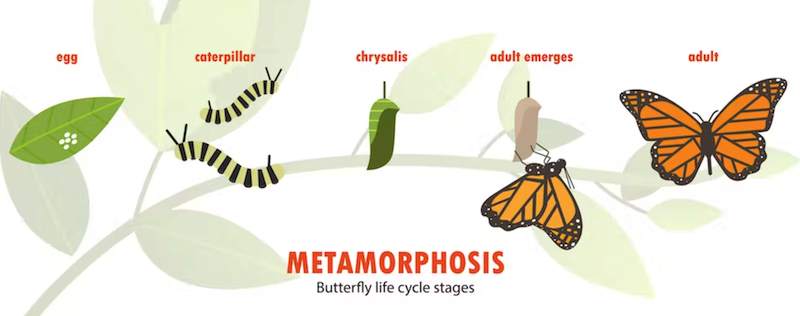Caterpillars are not butterflies.
Sure, sure… butterflies emerge from caterpillars, but just pretend you didn’t know that part. There’s no way you would ever assume that a butterfly began as a caterpillar any more than you’d think a bird started off its life as a worm. Which, for clarity, it didn’t.
In fact, they are on completely different sides of the food chain.
There are some pretty stark differences between caterpillars and butterflies. As different as a human is to a seahorse. For instance:
- One eats only solids the other only liquids
- One has six eyes the other only two
- One sees black and white the other color
- One has reproductive organs the other doesn’t
I’m telling you… they aren’t the same. Not even close.
Think of any other living being in its state as a child and then as an adult – there’s continuity in its growth. A baby bird looks and acts like an adult bird. A baby fish looks and acts like an adult fish. A baby human looks and acts like an adult human (you know what I mean).
But a baby butterfly looks and acts nothing like a butterfly.
If you know an entrepreneur or, God forbid, you ARE an entrepreneur, this is critically important to understand.
Read on, Rabbit…

The Cater-preneur
There simply isn’t a better metaphor for personal transformation than that of the caterpillar becoming a butterfly.
However (and this is a big however), the fun fact they don’t tell you is that only 1% of caterpillars actually make it all the way to becoming butterflies. The other 99% fail.
On another note, less than 1% of entrepreneurs are able to grow their business above $10 million. The other 99% fail to do so.
Coincidence?
I didn’t think so either.
Now before you get your cute little Paw Patrol panties in a bundle, I’m not saying that entrepreneurs are caterpillars.
On the other hand, maybe I am.
Ok, let’s run with this.

Entrepreneurs are Like Caterpillars
It takes a special type of borderline personality to take a twinkle of an idea in one’s brain and build it into something that people will pay for.
The vast majority of those who try to do this will fail within their first two years. They will never even get to $1m in revenue before their company goes belly-up. Or bottom-up. Or whatever is supposed to go up in those instances.
A very select few will be able to bring it closer to $5m in revenue. And, as mentioned above, less than 1% of entrepreneurs can scale their companies beyond $10m.
There’s a reason for this and, yes, it’s about caterpillars.
In order for caterpillars to reach maturity, they must dramatically change their behavior. This change is so substantial that, after the transition, you can barely recognize that the thing was ever a caterpillar at all.
As we said, only 1 in 100 caterpillars can get that far.
Similarly, the type of leadership style that is needed to start a company from scratch is very different than the leadership needed to scale a company.
It requires a transformation not unlike a caterpillar to a butterfly, which is no small feat – just ask the next butterfly you see.

The Caterpillar Leader
The start-up leader (aka the Caterpillar Leader) is a unique breed. In order for them to start a company, they need a distinctive set of skills. This includes:
Strong Competitive Drive
A burning desire to be the best
Anxiety
A continuous fear that you won’t be the best
Agility / ADD
Ability to quickly change direction in order to determine a product-market fit that will make you the best
Sales-focus
A relentless search to get new customers and convince them you’re the best. You’ll figure out the rest after you land them.
Reactivity
A focus on the biggest vulnerabilities stopping you from being the best and an overwhelming will to address them immediately
You may know a person just like this.
Brilliant? Maybe.
Sociopathic? Probably.
Now imagine that start-up leader mentality is in charge of an early growth company – one with 30+ employees and ~$10m in revenue. Just picture the culture that would ensue.
In fact, I’ll help you picture that culture because it looks a lot like this picture here…

When A Caterpillar Leader Leads
While the startup leader mentality must continually pivot priorities to chase the money and product/market fit, by the time the company reaches about $10m, the fit has been well established.
The traits of the startup mindset, though critical for early success, become a detriment to a company’s scalability.
Here is what usually permeates companies in the early growth/~$10m stage when they are led by a startup-minded leader:
- Lack of accountability
- Poor customer experiences
- Lack of scalable processes
- Increasingly horrendous culture
- Lack of ability to scale revenue

The Butterfly Leader
Early growth leaders (aka Butterfly Leaders) must understand that scalable processes are the key to success.
Whereas startups are sales-driven and must change tactics to meet the needs of the market, early-growth companies must transform to a more process driven culture.
Processes are essential in this stage. Without processes, there is no scale. Without processes, there is confusion and frustration among the employees.
The leaders must understand that employees of growth companies want to have clarity, consistency, and reliability in their jobs. They didn’t sign up for the schizophrenia of a startup environment.
Unfortunately, most startup leaders are not wired to create consistent, reliable, and highly scalable processes.
Most start-up leaders believe the thinking that got them to $5m in revenue is the same type of thinking that will get them well above $10m.
It’s not and it won’t.
When a start-up Caterpillar Leader fails to grow into the new role as an early growth leader, one of two things will happen. Either:
1) They will lose their job, or
2) They will perform so poorly that the company will never scale and will eventually fade away or crash and burn.
Exhibiting start-up behavior in an early growth environment will make employees want to thwack a waffle iron upside the leader’s head.
The reactivity and anxiety that was critical in the early stages must be put away and forgotten. Most entrepreneurial leaders can’t do this.
To be fair, we all expect start-up leaders to simply change who they are, yet just about every human on this planet has a tough time dramatically altering their innate personality.
Imagine if you are a right-brained creative and were told that in order to keep your job you need to become a left-brained analytical person. It’s not that easy.
That doesn’t make anyone a failure.
It’s like asking a caterpillar to morph into a butterfly. And we all know how rare that is.
Somewhat Relevant Quote
“The single biggest way to impact an organization is to focus on leadership development.” at whatever cost.”
Arthur Ashe, Tennis god and all-around superhero
Random News
Peace And… – You want quiet? Try this out. I dare you.
Four + Three – The results are in. We’re better with four.
Picasso Country – The most interesting fact about Greenland
eMooseji – Finally, a moose emoji and more.
